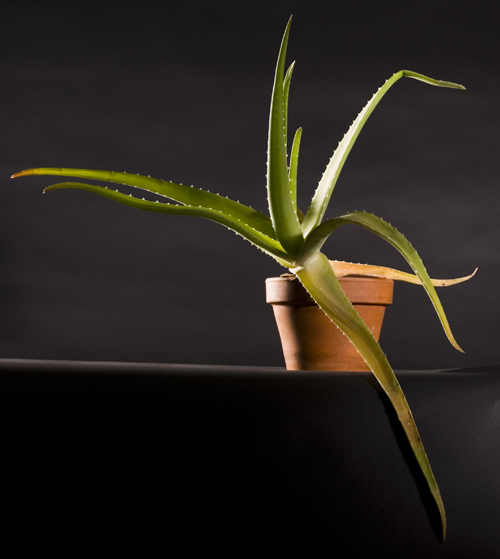 Aloe vera:
Aloe vera:  Aloe vera:
Aloe vera: When I was young, my mother always kept an Aloe vera plant around the house; she used it any time one of us got burned. I never understood much about the thick-leafed plant. However, given that I highly value its soothing properties in treating burns, I figured it would be appropriate for this science photographer to research this still largely-mysterious plant.

Aloe is a genus of succulent plants, meaning that it exhibits a high rate of water retention. There are some 400 species of Aloe worldwide. A. vera is the most common form of the Aloe plant. This species is believed to originate in northern Africa; like other species, nevertheless, it lacks a definitive area of origin, given the wide geographic range in which the plant can grow and thrive. Some species are spotted, as is the case of the one featured here. This species is known as A. vera var. chinensis.
Aloe vera has thick, fleshy leaves. The leaves are lance-shaped, meaning that they start wide and taper to a point. Their serrated margins are studded with distinct little teeth that are characteristic of Aloe plants. Inside the Aloe leaf are little elastic vacuoles; these pockets, similar in appearance to a collection of soap bubbles, contain a "yellow, resinous latex"-like substance. This product of the Aloe plant is of great interest to many industries; it will be discussed later in detail.
The root system of the Aloe plant tends to grow wide, but not deep into soil. (Potted Aloe plants are typically moved to wider, but not deeper pots as they grow.) This would make sense, as the arid climates they tend to grow in see little rainfall. (Cacti are a similar example of plants with a shallow root system.) One important feature of the root system is that it forms arbuscular mycorrhiza, a fungus that penetrates inside the roots to allow the plant "better access to mineral nutrients in the soil."
Click on any image to view the Image Gallery, with larger views and descriptions of each photograph.
Continue to Page 2: Applications of Aloe vera
To get in contact with me, please email me at doherty.glenn@gmail.com If you cannot reach me at the above address, please email my professor, Michael Peres,with any questions: mrppph@rit.edu |
All text and images ©Glenn Doherty, 2008. Reproduction without permission is prohibited.
Permission for use of any images can be granted by emailing me at doherty.glenn@gmail.com.
Return to index of articles
by students on the 'Principles and techniques of photomacrography'
course, November 2008,
Biomedical Photographic Communications (BPC)
program at the Rochester Institute of Technology (RIT).
Article hosted on Micscape Magazine (Microscopy-UK).